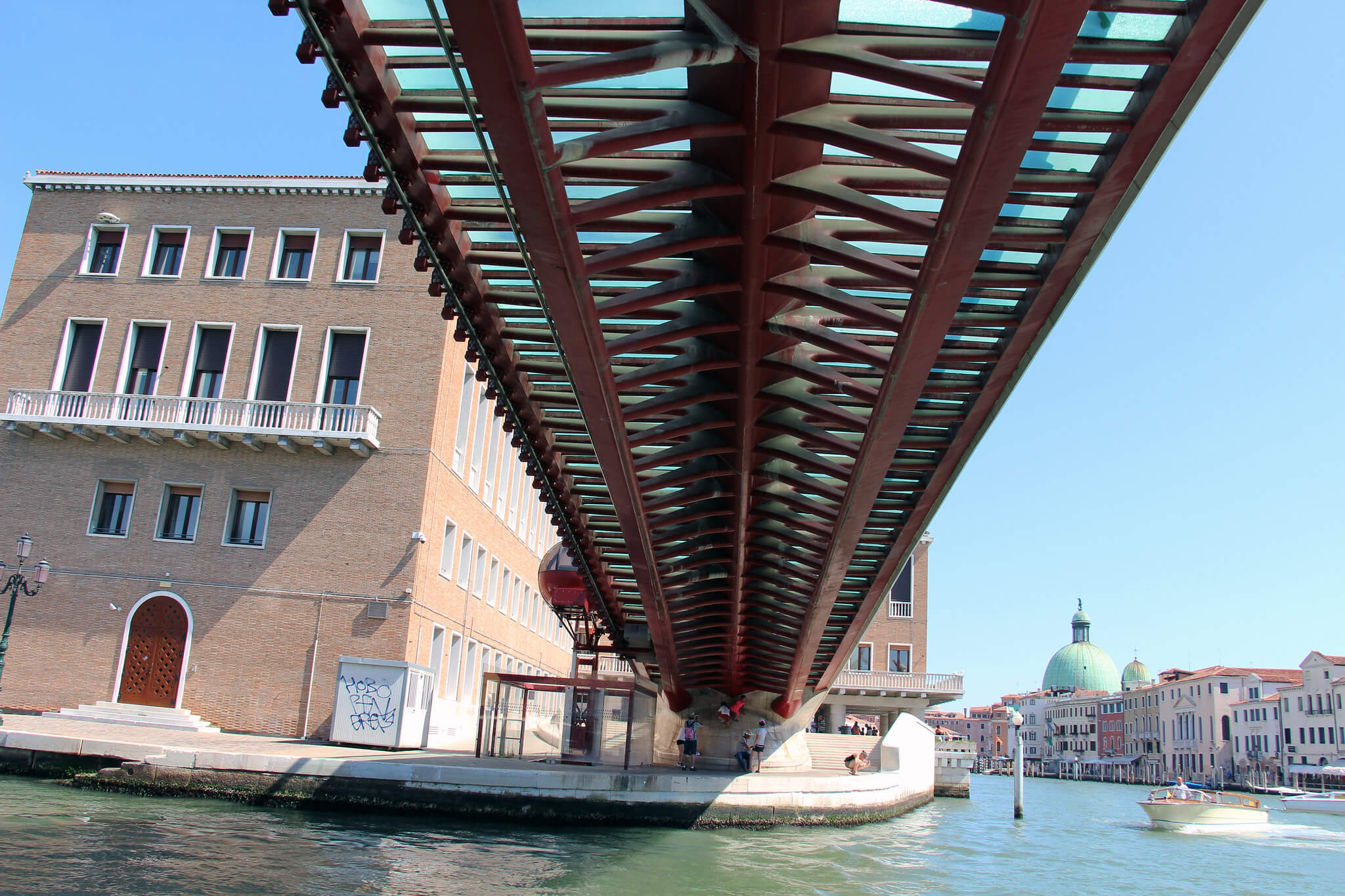Fourteen years, countless slips and falls, multiple lawsuits, and one hefty fine for “negligence” after it first opened to the public, the Santiago Calatrava-designed Ponte delle Costituzione (Constitution Bridge) spanning Venice’s Grand Canal could get a major overhaul to render it less precarious.
In the years since the notoriously slippery glass-bottomed steel footbridge’s 2008 inauguration, city officials have instituted several measures to prevent embarrassing and sometimes litigation-sparking tumbles including posting cautionary signage, installing resin pads and nonslip stickers, and even laying a strip of trachyte stone across the middle of the 300-foot-long arch truss structure. Still, nothing has stuck and now Venice has plans to replace the entire glass section of Constitution Bridge—simply known, perhaps a bit scornfully, as the “Calatrava Bridge” among locals—with stone.
As recently reported by the New York Times, the city has dedicated roughly $565,000 (500,000 euros) to the replacement scheme, which Calatrava has come out in full support of per a statement provided by his office that AN has published in full below. A firm timeline hasn’t yet been established for the project as structural tests must be carried out first and the plan must also win approval from Venice’s architectural authority. But time is of the essence given the “almost daily” occurrence of spills on the bridge per Francesca Zaccariotto, the city’s public works official.
“People hurt themselves, and they sue the administration,” Zaccariotto told the Times. “We have to intervene.”
The winter months can be especially perilous as the bridge’s tempered glass steps, which alternate with Istrian stone, become slick during cold and damp weather. However, in a 2019 call with AN, Calatrava’s eponymous firm argued that the steps are “no more slippery than other parts of the city.”

Following the publication of the Times article, Calatrava’s office offered this statement in response to news of the city’s plan:
“Ponte della Costituzione has been highly praised by the city of Venice and its users since opening in 2008, becoming one of the most beautiful bridges in the world. The original glass paving installed on the bridge consisted of an anti-slippery upper surface that complied with all local regulations and was tested and considered suitable by all control departments of the administration. In the daily use of the bridge, the inadequate use of certain heavy elements or even acts of vandalism have led to the breaking of some glass panes of the original flooring, which unfortunately were later replaced with inadequate glass. In the current situation, our office supports the Municipality’s substitution of glass panes for trachyte stone paving slabs, consistent with the bridge design and the surrounding cityscape to maintain its beauty and functionality.”
First commissioned for the project in 1999, the Spanish architect and structural engineer famed for his audacious landmark bridges has firmly stood by his design for the nearly $13 million Constitution Bridge, which was beset by years of delays and has been polarizing from the get-go due in part to its high cost, modern aesthetic, and location in close proximity to the 1930s-era Ponte degli Scalzi, one of only three other bridges spanning the Grand Canal. Boasting postcard-perfect views along the western end of the Grand Canal, Constitution Bridge serves as a major gateway for Venice as it links Piazzale Roma, home to the city’s main bus hub, with the Santa Lucia railway station. The bridge, in turn, is a particularly high-traffic one and many of the tourists who traverse it are distracted and lugging rolling luggage behind them, a factor that likely contributes to the high number of falls.
Given that Calatrava’s design is also a stair-heavy one, accessibility issues have also long been a concern. In 2013, a costly lift system featuring an egg-shaped cabin was installed at the bridge following complaints. In 2019, the lift system was nixed and later dismantled to the tune of roughly $44,000 for safety reasons including frequent overheating in the summer months. Calatrava played no part in the design or construction of the failed lift system. His firm told AN in 2019 that a stairlift designed by Calatrava was part of the original bridge design although the city council rejected it at the time, deciding that wheelchair users and those with limited mobility could take a water taxi across the canal instead.











